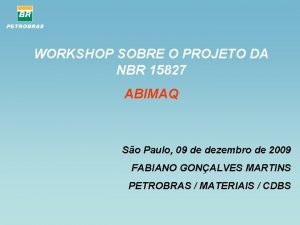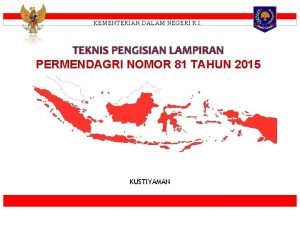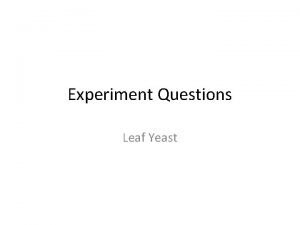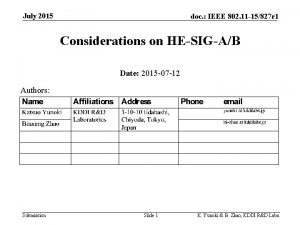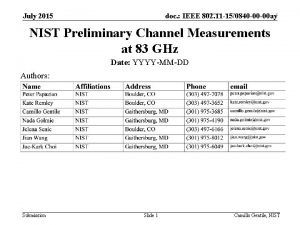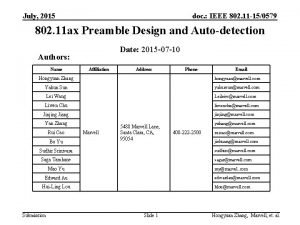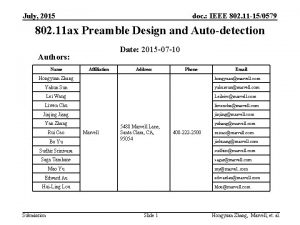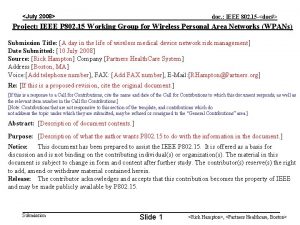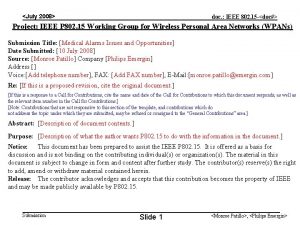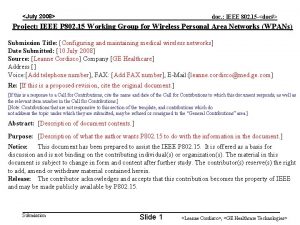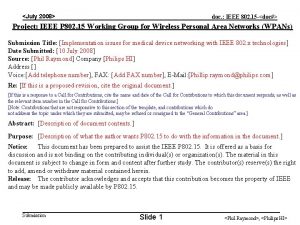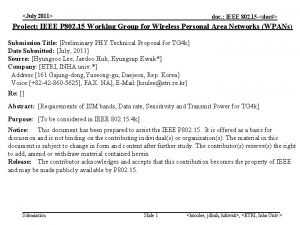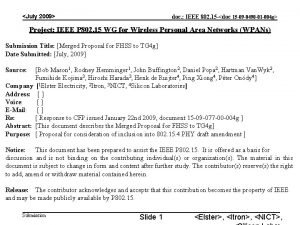July 2015 doc IEEE 802 11 15827 r













![July 2015 doc. : IEEE 802. 11 -15/827 r 0 References • • [1] July 2015 doc. : IEEE 802. 11 -15/827 r 0 References • • [1]](https://slidetodoc.com/presentation_image_h2/99b65676b34315e57efa078f8b4a9e14/image-14.jpg)
- Slides: 14

July 2015 doc. : IEEE 802. 11 -15/827 r 0 Considerations on HE-SIG-A/B Date: 2015 -07 -12 Authors: Submission Slide 1 K. Yunoki & B. Zhao, KDDI R&D Labs.

July 2015 doc. : IEEE 802. 11 -15/827 r 0 Abstract • This submission shows the following considerations on HE-SIG-A and HE-SIG-B for DL-OFDMA: • #1 Possible contents for HE-SIG-B • #2 HE-SIG-B configurations • #3 Possible decoding optimization Submission Slide 2 K. Yunoki & B. Zhao, KDDI R&D Labs.

July 2015 doc. : IEEE 802. 11 -15/827 r 0 Consideration #1: MCS per OFDMA Resource Unit We agreed some patterns for OFDMA building blocks at May 2015 meeting. [2] It is preferable for each resource unit to use different MCS for better efficiency. Combination of resource units also should be identified for each transmission. e. g. Combination of resource units 16 OFDMA assignments in 80 MHz BSS (ref: slide 30 of 15/330 r 5) Proposal #1: Resource unit assignment and MCS for respective resource unit will be contents in HE-SIG-B. Submission Slide 3 K. Yunoki & B. Zhao, KDDI R&D Labs.

July 2015 doc. : IEEE 802. 11 -15/827 r 0 Consideration #1: e. g. Expression of HE-SIG-B RU = Resource Unit RU QTTY RU Info #1 RU Info #2 8 8 8 Bits: RU width 3 MCS 4 reserved This is just an example. It can be optimized more. Submission 1 …. RU Info #n 8 RU width: • 0: SU • 1: 26 tones • 2: 52 tones • 3: 106 tones • 4: 242 tones • 5: 484 tones MCS: MCS index for 11 ac are 0~9. 4 bits will be enough. It can be expressed in 3 bits. Slide 4 K. Yunoki & B. Zhao, KDDI R&D Labs.

July 2015 doc. : IEEE 802. 11 -15/827 r 0 Consideration #2: Possible Configurations of HE-SIG-B [3][4] • Option-A. Duplicated HE-SIG-B per 20 MHz • Option-B. Non-duplicated HE-SIG-B per 20 MHz variable Primary 20 MHz variable L-Part HEHESIG-B SIG-A 1 Dup. L-Part Dup. HEHE- SIG-B 2 SIG-A Dup. HESIG-B Dup. L-Part Dup. HEHE- SIG-B 3 SIG-A Dup. HESIG-B Dup. L-Part Dup. HEHE- SIG-B 4 SIG-A L-Part HESIG-A HESIG-B Dup. L-Part Dup. HESIG-A Primary 20 MHz . . . • Option-D. HE-SIG-B per resource unit frequency • Option-C. Entire-channel HE-SIG-B . . . variable Primary 20 MHz Submission L-Part HESIG-A Dup. L-Part Dup. HESIG-A 4µs per OFDM Symbol … HESIG-B . . . HESIG-A … 16µs per OFDM Symbol HE-SIG-B 10 MHz HE-SIG-B 20 MHz … time HE-SIG-A needs to have segment information of resource units. It’s not feasible. That big information will not fit in HE-SIG-A. Slide 5 K. Yunoki & B. Zhao, KDDI R&D Labs.

July 2015 doc. : IEEE 802. 11 -15/827 r 0 Consideration #2: Required OFDM Symbols Max. QTTY of RU Max. size of HE-SIG-B (required bits) 20 M 9 40 M BW Required OFDM symbols for HE-SIG-B (64 FFT) * A B C 80 4 4 4 18 152 7 4 4 80 M 37 304 13 4* 4 160 M 74 600 25 4* 4 Note-1) HE-SIG-B structure on Slide-4 is assumed. Note-2) 48 available subcarriers and coding rate = 1/2 are assumed per 20 MHz. * It’s subject how to express the resource units across two 20 MHz. (next slide) Option-A isn’t efficient. It may not be practical. Proposal #2: HE-SIG-B should not be duplicated in every 20 MHz as Option-A. Submission Slide 6 K. Yunoki & B. Zhao, KDDI R&D Labs.

July 2015 doc. : IEEE 802. 11 -15/827 r 0 Consideration #2: An Issue on Option-B Some resource units are across two 20 MHz sub-bands. How can we express these resource units in Option-B case? ? Submission Slide 7 K. Yunoki & B. Zhao, KDDI R&D Labs.

July 2015 doc. : IEEE 802. 11 -15/827 r 0 Consideration #3: Decoding Issue for DL-OFDMA? ? • Definitive destination address will be acquired from decoded MAC frame. A receiving STA has to decode all resource units to pick up a desired MAC frame. : Minimum required portion for decoding Option-B. Primary 20 MHz Option-C. L-Part HEHESIG-B SIG-A 1 Dup. L-Part Dup. HEHE- SIG-B 2 SIG-A L-Part HESIG-A Dup. L-Part Dup. HEHE- SIG-B 3 SIG-A Dup. L-Part Dup. HEHE- SIG-B 4 SIG-A Dup. L-Part Dup. HESIG-A Primary 20 MHz . . . HESIG-B . . . It may be complicated for a receiving STA to decode the entire DL-OFDMA frame of multi-resource units with various MCSs and resource segmentations. Submission Slide 8 K. Yunoki & B. Zhao, KDDI R&D Labs.

July 2015 doc. : IEEE 802. 11 -15/827 r 0 Consideration #3: Possible Optimization for Decoding Schemes • When HE-SIG-A has an indication for sub-band selection, a receiving STA may be able to limit decoding portion just for a specific 20 MHz. • That indication will be with Multi-Access (MA) group ID. (Need further studies) : Minimum required portion for decoding Option-B. Primary 20 MHz Indication for sub-band selection L-Part HEHESIG-B SIG-A 1 Dup. L-Part Dup. HEHE- SIG-B 2 SIG-A Figures below are examples that are indicated in HE-SIG-A as 2 nd 20 M to be decoded. Option-C. Not well-optimized L-Part HESIG-A Dup. L-Part Dup. HEHE- SIG-B 3 SIG-A Dup. L-Part Dup. HEHE- SIG-B 4 SIG-A Dup. L-Part Dup. HESIG-A Primary 20 MHz . . . HESIG-B . . . This optimization may reduce required processing power to decode DL-OFDMA frame on a receiving STA. I’m not sure if this is true. Submission Slide 9 K. Yunoki & B. Zhao, KDDI R&D Labs.

July 2015 doc. : IEEE 802. 11 -15/827 r 0 Consideration #3: Issues • MA Group Indication: • How to make up the group for each sub-band? • Resource units across two 20 MHz sub-bands: • The same issue as Slide-7 • Others? Submission Slide 10 K. Yunoki & B. Zhao, KDDI R&D Labs.

July 2015 doc. : IEEE 802. 11 -15/827 r 0 Conclusion • Some contents of HE-SIG-B are proposed for DLOFDMA PPDU. - Resource unit assignment (RU QTTY, RU width) - MCS per RU • HE-SIG-B should not be duplicated on every 20 MHz sub-band for better efficiency. • Sub-band selection measure in HE-SIG-A was proposed as a potential optimization. It may possibly reduce required processing power to decode DL-OFDMA PPDU on a receiving STA. Submission Slide 11 K. Yunoki & B. Zhao, KDDI R&D Labs.

July 2015 doc. : IEEE 802. 11 -15/827 r 0 Straw Poll #1 • Do you agree to add the following text into 11 ax SFD? 3. 2. 3 HE-SIG-B includes resource unit assignment and MCS per resource unit for DL-OFDMA PPDU. Y/N/A = Submission Slide 12 K. Yunoki & B. Zhao, KDDI R&D Labs.

July 2015 doc. : IEEE 802. 11 -15/827 r 0 Straw Poll #2 (not for Motion) • Do you think that a sub-band selection measure at reception of DL-OFDMA PPDU will help to reduce required processing power on a receiving STA? Y= N= Interesting, but need more studies = I don’t care = Submission Slide 13 K. Yunoki & B. Zhao, KDDI R&D Labs.
![July 2015 doc IEEE 802 11 15827 r 0 References 1 July 2015 doc. : IEEE 802. 11 -15/827 r 0 References • • [1]](https://slidetodoc.com/presentation_image_h2/99b65676b34315e57efa078f8b4a9e14/image-14.jpg)
July 2015 doc. : IEEE 802. 11 -15/827 r 0 References • • [1] doc. 11 -15/132 r 5, “Specification Framework for TGax” [2] doc. 11 -15/330 r 5, “OFDMA Numerology and Structure” [3] doc. 11 -15/621 r 2, “Design Principles for HE Preamble” [4] doc. 11 -15/557 r 0, “Preamble Structure in 802. 11 ax” Submission Slide 14 K. Yunoki & B. Zhao, KDDI R&D Labs.
